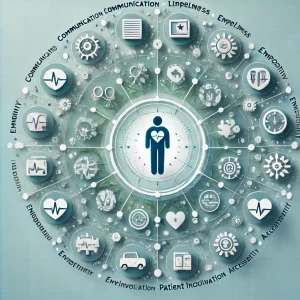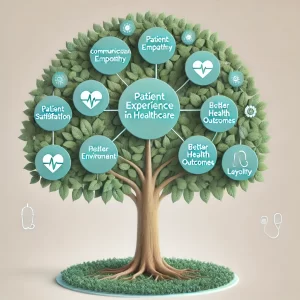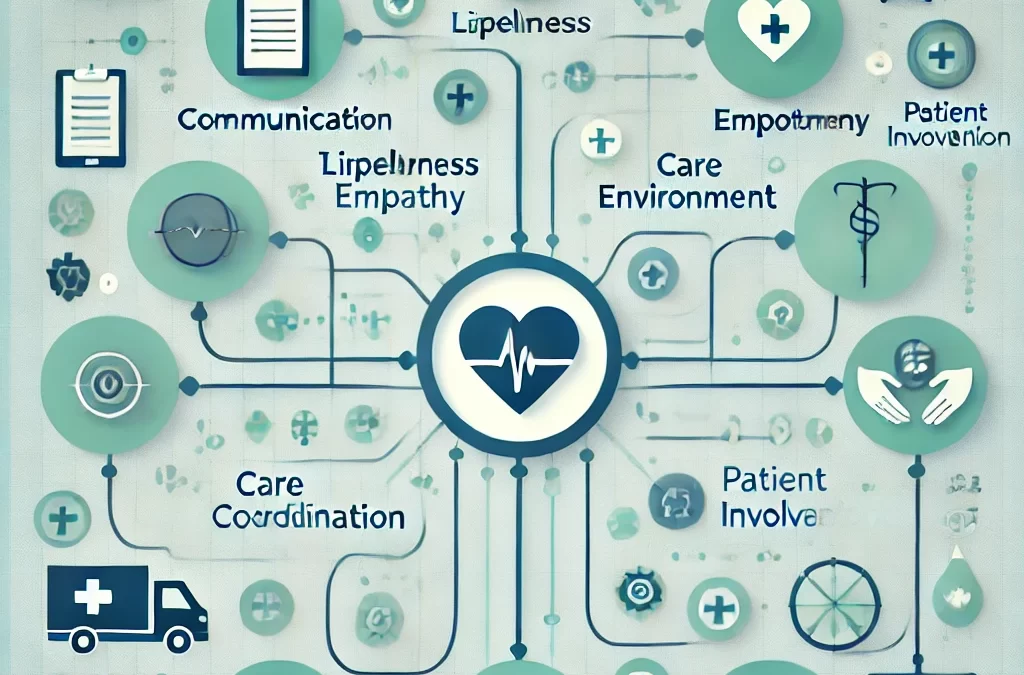Optimizing patient experience is crucial in today’s healthcare landscape. The shift from traditional practices to patient-centered care has transformed how providers interact with patients. Historically, healthcare providers focused primarily on treatment rather than patients’ overall flow and experience, a fact that has changed over time. Today, improving communication, reducing wait times, and enhancing comfort are vital components of care.
Healthcare professionals must prioritize understanding patient needs and preferences. By doing so, they can improve patient experience and create a supportive environment that fosters trust and satisfaction in health-provider interactions. This approach improves health outcomes and builds long-term relationships between patients and providers. Emphasizing these aspects leads to a more effective healthcare system and happier patients.
Key Takeaways 
Focus on understanding patient experience by actively listening to their needs and concerns, which helps build trust and satisfaction.
Use effective communication techniques, like clear explanations and empathy, to enhance patient interactions and make them feel valued.
Leverage technology by adopting telehealth and patient portals to provide convenient access to care and information.
Streamline patient flow by optimizing scheduling and reducing wait times, which can lead to a more pleasant visit for patients.
Collect and analyze feedback regularly through surveys or direct conversations to identify areas for improvement in the patient experience.
Implement improvement strategies based on feedback and data analysis to continually enhance the quality of care and patient satisfaction.
Understanding Patient Experience
Definition and Importance
Patient experience refers to all interactions patients have with the healthcare system. This includes everything from scheduling appointments to receiving treatment and follow-up care. Positive patient experiences lead to better health outcomes. Patients who feel valued in their health are more likely to adhere to treatment plans.
Optimizing patient experience is essential for building trust and loyalty. Trust encourages patients to seek care when needed. Loyalty ensures that patients return to the same health provider for future needs. Healthcare providers must focus on enhancing these experiences to improve the overall care experience.
Current Trends in Patient Satisfaction
Several key trends shape patient satisfaction today. There is an increased demand for personalized care. Patients want services tailored to their individual needs. Digital engagement also plays a significant role. Many patients prefer using apps or websites for appointments and consultations.
The importance of patient feedback is growing. Providers now actively seek input through patient experience surveys. This feedback helps shape healthcare services based on actual patient experiences. Another trend is the shift toward value-based care models. These models emphasize patient satisfaction metrics alongside clinical outcomes.
Key Challenges in Patient Experience
Barriers exist that hinder positive patient experiences. Communication gaps between staff and patients can lead to misunderstandings. Lack of staff training often results in inconsistent service quality.
Systemic issues also affect patient experience. Long wait times frustrate patients and decrease satisfaction levels. Inadequate follow-up care can leave patients feeling neglected after treatment.
Healthcare costs present another challenge. High expenses can limit access to necessary services, impacting overall satisfaction. Patients may avoid seeking care due to financial concerns, leading to worse health outcomes.
Effective Communication
Active Listening Skills
Healthcare providers should practice active listening. This skill helps them understand patient needs better. It involves fully concentrating on what the patient says. Providers must validate patient concerns to enhance their experience. A simple acknowledgment can make a significant difference. Techniques like summarizing and reflecting back improve communication. For example, if a patient expresses worry about a procedure, the provider can summarize those concerns. This shows the patient they are heard and understood.
Active listening also builds trust. Patients feel comfortable sharing their feelings. They open up more when they know someone is truly listening. This connection can lead to better health outcomes. When patients feel valued, they are more likely to follow treatment plans.
Setting Clear Expectations
Clear communication about treatment plans is crucial. It reduces anxiety for patients. Providers should explain what to expect during their healthcare journey. This includes outlining procedures and possible outcomes.
Providing written materials reinforces verbal instructions. Patients often forget details after appointments. Handouts or brochures can help them remember important information. They can review these materials at home when needed.
Setting clear expectations also includes discussing insurance coverage. Patients need helpful information about costs upfront. This transparency prevents surprises later on and allows them to make informed decisions about their care.
Enhancing Patient-Provider Interaction
A welcoming environment fosters positive interactions. Friendly and approachable staff behavior makes a difference in patient experiences. Staff should greet patients with smiles and offer assistance.
Technology plays a role in improving communication as well. Online portals allow patients to access their health information easily. They can send messages to providers without waiting for an appointment. This convenience helps patients feel more in control of their healthcare.
It is also essential to train staff to engage in meaningful conversations. Staff should ask open-ended questions, allowing patients to express themselves fully. Prioritizing patient comfort leads to better relationships between patients and providers.
Providers can also encourage patient feedback. This feedback offers insights into what communication strategies work well and what needs improvement.
Leveraging Technology
Digital Engagement Tools
Patient portals and mobile apps serve as essential digital tools. They enhance patient engagement by allowing easy access to personal health information. Patients can view lab results, schedule appointments, and communicate with providers. This convenience fosters a stronger connection between patients and healthcare professionals.
Telehealth plays a crucial role in this transformation. It provides patients with convenient access to healthcare services from their homes. Virtual visits eliminate the need for travel, saving time and reducing exposure to illnesses.
Reminders and notifications are also vital. They keep patients informed about upcoming appointments or medication schedules. This proactive approach encourages better adherence to treatment plans.
Benefits of Telehealth Services
Telehealth significantly expands access to care. Remote patients can connect with healthcare providers without long trips, which is especially beneficial for those living in rural areas.
Another key advantage of virtual visits is convenience. Patients avoid long wait times in clinics or hospitals and can consult with doctors from the comfort of their homes, making healthcare more accessible.
Telehealth platforms can improve follow-up care. Providers can easily check on patients’ progress after procedures or treatments, and regular virtual check-ins help maintain continuity of care.
 Using Real-Time Data Analytics
Using Real-Time Data Analytics
Data analytics play a pivotal role in monitoring patient satisfaction. Healthcare organizations can analyze feedback to identify areas needing improvement. This real-time insight helps shape better patient experiences.
Personalized care is achievable using data insights. By understanding individual patient preferences, providers can tailor interactions accordingly, enhancing the overall quality of care delivered.
Predictive analytics further streamline services. Anticipating patient needs allows healthcare systems to allocate resources efficiently. For instance, knowing when patients are likely to seek care can help manage staffing levels effectively.
Key Takeaways for Enhancing Patient Experience in Healthcare
Streamlining Patient Flow
Optimizing Flow Efficiency
Patient flow analysis is crucial. It helps identify bottlenecks in the healthcare system’s efficiency. For example, long wait times can occur due to inefficient scheduling or inadequate staffing. Hospitals should review their processes regularly. This review can guide improvements that ensure timely care and reduce delays.
Teamwork among staff is also essential. Nurses, doctors, and administrative personnel must communicate effectively. This collaboration enhances operational efficiency and allows for a smoother patient experience.
Reducing Wait Times
Minimizing patient wait times is vital for satisfaction. Developing better scheduling practices can help achieve this goal. Hospitals can use data to predict busy periods and allocate resources accordingly.
Implementing triage systems is another effective strategy. These systems prioritize urgent cases, ensuring that critical patients receive prompt attention. Regular monitoring of wait times allows hospitals to identify trends. Adjustments based on these trends can lead to continuous improvement.
Minimizing Length of Stay
Timely discharge processes are key to minimizing length of stay. Assessing these processes helps ensure efficient patient transitions from hospital to home. Delays in discharge can lead to increased costs and dissatisfaction.
Collaboration with multidisciplinary teams is essential. These teams address patient needs proactively, leading to better outcomes. For instance, a team might include doctors, nurses, social workers, and pharmacists who work together for comprehensive care.
Educating patients on post-discharge care is equally important. Providing clear instructions helps prevent unnecessary readmissions. Patients who understand their care plans are more likely to follow them, reducing the chance of complications.
Collecting and Analyzing Feedback
Importance of Patient Surveys
Patient surveys serve as a crucial tool for gathering feedback. They help healthcare providers understand patient experiences. Surveys can reveal both strengths and weaknesses in care delivery. For example, a hospital may find that patients appreciate the staff’s friendliness but feel the wait times are too long. Regular distribution of surveys allows facilities to track changes in patient satisfaction over time. This ongoing process is essential for continuous improvement.
Methods to Collect Feedback
Diverse methods exist for collecting patient feedback. Online surveys are popular due to their convenience. Focus groups also provide valuable insights through direct discussions. Engaging patients in conversations allows staff to gather qualitative information about their experiences. This approach can uncover issues not always captured by surveys. Ensuring anonymity and confidentiality is vital. Patients are more likely to share honest feedback when they feel secure.
Analyzing Survey Results
Survey data must be systematically analyzed. This analysis uncovers trends and actionable insights. For instance, if multiple patients report similar concerns, it signals an area needing attention. Sharing findings with staff fosters a culture of continuous improvement. Staff members can learn from patient feedback and make necessary adjustments. Using results to inform strategic decisions significantly enhances patient care initiatives.
Implementing Improvement Strategies
Staff Training Programs
Healthcare organizations must invest in comprehensive training programs. These programs should focus on communication and empathy skills. Training staff to connect with patients is essential. Role-playing scenarios can help prepare staff for real-world patient interactions. This hands-on approach builds confidence and improves service quality.
Regular updates to training materials are crucial. These updates should reflect current best practices in patient care. Staff needs to stay informed about new techniques and protocols. This ongoing education fosters a culture of excellence within the organization.
Resource Allocation Techniques
Assessing resource needs is vital for healthcare organizations. Understanding patient volume and service demand helps optimize operations. Staff schedules should align with peak patient times. This alignment ensures better service delivery during busy periods.
Strategic resource allocation enhances the patient experience across all departments. For example, additional staff may be necessary if a particular department sees high traffic. This proactive approach prevents long wait times and improves overall satisfaction.
Continuous Quality Improvement
Establishing a framework for ongoing assessment is necessary for enhancing patient experience. Regular evaluations help identify areas needing improvement. Encouraging a culture of feedback empowers staff to suggest changes. Their insights can lead to valuable enhancements in care delivery.
Healthcare organizations should regularly review policies and procedures. Ensuring alignment with patient-centered care principles is key to success. Adjustments based on feedback foster an environment focused on meeting patient needs.
Closing Thoughts
Optimizing patient experience is crucial for healthcare success. You’ve learned how effective communication, technology, streamlined processes, and feedback can transform interactions. Each element plays a role in creating a welcoming environment.
Now it’s time to take action. Implement these strategies in your practice. Focus on patient needs and watch satisfaction soar. Remember, a positive experience leads to better outcomes for everyone involved. Start today and make a difference in your patients’ lives.
Frequently Asked Questions
What is patient experience?
Patient experience refers to the sum of all interactions a patient has with the healthcare system, including communication, care quality, and overall satisfaction.
Why is optimizing patient experience important?
Optimizing patient experience enhances satisfaction, improves health outcomes, and fosters trust in healthcare providers, leading to better patient retention.
How can effective communication improve patient experience?
Effective communication builds rapport, clarifies treatment plans, and ensures patients feel heard and valued, directly enhancing their overall experience.
What role does technology play in patient experience?
Technology streamlines processes facilitates remote consultations, and provides easy access to medical records, making healthcare more convenient for patients.
How can feedback be used to optimize patient experience?
Collecting and analyzing feedback helps identify pain points, allowing healthcare providers to make targeted improvements that enhance overall patient satisfaction.
What are some strategies for implementing improvements in patient experience?
Strategies include training staff on empathy, efficiently utilizing technology, and regularly reviewing feedback to adapt services based on patient needs.
How can streamlining patient flow benefit patients?
Streamlining patient flow reduces wait times, enhances service delivery, and creates a more efficient healthcare environment, ultimately improving the patient experience.

